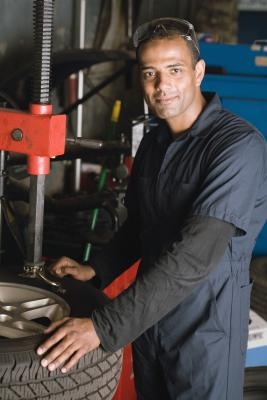
The heart of a 2001 Chevy Blazer's fuel system is the electric fuel pump mounted internally in the fuel tank. The fuel system on the Blazer is quite sophisticated, which makes troubleshooting a tricky process. The power supply to the fuel pump is computer operated and routed through several fuse blocks and a fuel pump relay. When fuel system issues arise one of the first potential causes to eliminate is the fuel filter. You do this by replacing it. The filter is located under the Blazer near the driver's side frame rail between the fuel tank and the engine compartment.
Spray a small amount of starting fluid into the Chevy Blazer's aircleaner while cranking the starter. If the Blazer starts up momentarily and stalls a few seconds after the starting fluid dissipates it indicates a fuel problem.
Check the fuse box for any blown fuses. This requires pulling every fuse out, one at a time. Check each fuse and replace it before pulling another one. To diagnose a blown fuse hold it up to the light; if there is gap or discolored burn mark in the metal insert replace it with a fuse of the same color and amperage.
Remove the top cover from the circuit box located under the hood, on the driver's side near the firewall. Check all the fuses by pulling one out checking it and replacing it before pulling another. Snap a picture of the circuit box with a cell phone camera before removing the fuel pump relay. Remove the fuel pump relay from the circuit box. The relay is labeled and pulls out like a fuse, if the relay smells burnt or the connections are corroded, replace it or have it tested. Most auto parts stores can test pump relays.
Thread the fuel pressure gauge onto the Schrader valve located on a fuel line or fuel rail, under the hood. The Schrader valve looks like a valve stem on a tire, it should have a plastic cap over it. The valve location varies due to the different type of fuel injections systems used. Trace the fuel lines out of the intake until the Schrader valve is located.
Place the fuel pressure gauge in view and turn the key to the on position, this should run the fuel pump for a few seconds. It is recommended that the fuel system be cycled by turning the key on and off three or four times to get an accurate pressure measurement, this requires a 20 second pause between key cycles. Generally a pressure of 55 to 61 psi, with the key on and engine not running, indicates the fuel pump is functioning properly.
Monitor the pressure if it was within the acceptable range when tested. Record the amount of time it takes for the pressure to bleed down. If the pressure gauge falls quickly check the fuel lines for leaks. If no pressure was detected proceed to the next step.
Remove the gas cap from the Chevy Blazer. Listen carefully near the filler tube while someone turns the key to the on position. The fuel pump should get a signal from the computer to run for a few seconds. You should hear a momentary motor noise from the fuel pump when it runs. To repeat this procedure, wait 20 seconds for the computer to reset. If no pump noise is detected it may indicate a faulty pump or a power interruption to the pump.
Rap the fuel tank with a non-metallic hammer in an effort to start the fuel pump. Once again remove the gas cap and listen close to the filler tube while someone turns the key to the on position. If you hear the pump motor, momentarily try to start the Blazer. If the Blazer starts, the fuel pump should be repaired or replaced, since it's not practical to constantly jar the pump into operation.